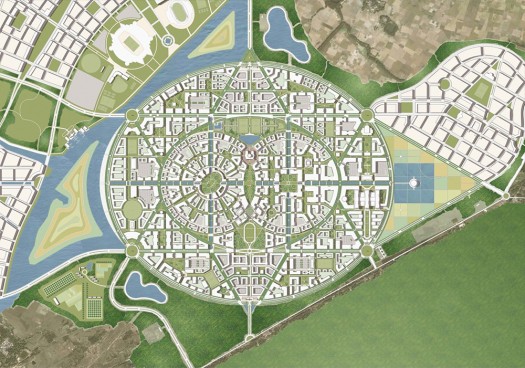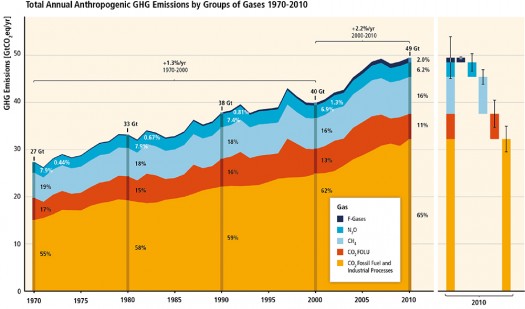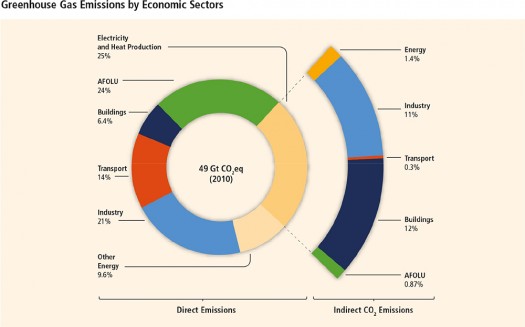A Placemaking Journal
Climate Change: A global commons problem
The report published week before last by the Intergovernmental Panel on Climate Change (IPCC) has made it clear that climate change is a global commons problem. The solution is to decouple rising temperatures from economic and population growth. Hundreds of the most prominent scientists with divergent political views from around the world have run thousands of scenarios, and I’m going to take a moment here to extract some of the land use issues woven through the report.
This is practical advice for city planners about how to move in a cleaner direction and pull as many local decision-makers as possible along with you. So “wonk alert” to our less technically interested readers, who may prefer this Yale 360 piece from prominent enviro thinkers about paths forward. Or this older piece by Emily Badger in Atlantic Cities about how reformatting the single family home’s relationship to its neighbourhood will help.
Strategies Related to City Planning in the IPCC Report
“Globally, economic and population growth continue to be the most important drivers of increases in CO2 emissions from fossil fuel combustion. The contribution of population growth between 2000 and 2010 remained roughly identical to the previous three decades, while the contribution of economic growth has risen sharply.” – IPCC
The impacts of how developing nations lay out and expand their cities is an important dialogue. A few inspiring plans come to mind, including some of Dhiru Thadini’s urban designs in India and Peter Calthorpe’s city plans in China.
For all of us, compact, walkable, mixed-use patterns are essential, and the emergent science of Eco-Districts is helping with infrastructure finance. DPZ’s work on Reinvent Phoenix is breaking new ground, supported by a large team of us, including Center for Neighborhood Technology and Crabtree Group.
“Mitigation options in urban areas vary by urbanization trajectories and are expected to be most effective when policy instruments are bundled. Infrastructure and urban form are strongly interlinked, and lock‐in patterns of land use, transport choice, housing, and behaviour. Effective mitigation strategies involve packages of mutually reinforcing policies, including co‐locating high residential with high employment densities, achieving high diversity and integration of land uses, increasing accessibility and investing in public transport and other demand management techniques.”
“The largest mitigation opportunities with respect to human settlements are in rapidly urbanizing areas where urban form and infrastructure are not locked in, but where there are often limited governance, technical, financial, and institutional capacities. The bulk of urban growth is expected in small‐ to medium‐size cities in developing countries. The feasibility of spatial planning instruments for climate change mitigation is highly dependent on a city’s financial and governance capability.”
“Thousands of cities are undertaking climate action plans, but their aggregate impact on urban emissions is uncertain. There has been little systematic assessment on their implementation, the extent to which emission reduction targets are being achieved, or emissions reduced. Current climate action plans focus largely on energy efficiency. Fewer climate action plans consider land‐use planning strategies and cross‐sectoral measures to reduce sprawl and promote transit‐oriented development.“
“Successful implementation of urban‐scale climate change mitigation strategies can provide co‐benefits. Urban areas throughout the world continue to struggle with challenges, including ensuring access to energy, limiting air and water pollution, and maintaining employment opportunities and competitiveness. Action on urban‐scale mitigation often depends on the ability to relate climate change mitigation efforts to local co‐benefits.“
“The transport sector accounted for 27% of final energy use and 6.7 GtCO2 direct emissions in 2010, with baseline CO2 emissions projected to approximately double by 2050.”
“Technical and behavioural mitigation measures for all transport modes, plus new infrastructure and urban redevelopment investments, could reduce final energy demand in 2050 by around 40% below the baseline.“
“Mitigation strategies, when associated with non‐climate policies at all government levels, can help decouple transport GHG emissions from economic growth in all regions. These strategies can help reduce travel demand, incentivise freight businesses to reduce the carbon intensity of their logistical systems and induce modal shifts, as well as provide co‐benefits including improved access and mobility, better health and safety, greater energy security, and cost and time savings.“
“In 2010, the building sector accounted for around 32% final energy use and 8.8 GtCO2 emissions, with energy demand projected to approximately double and CO2 emissions to increase by 50–150% by mid‐century. This energy demand growth results from improvements in wealth, lifestyle change, access to modern energy services and adequate housing, and urbanization. There are significant lock‐in risks associated with the long lifespans of buildings and related infrastructure, and these are especially important in regions with high construction rates.”
“Urbanization is a global trend and is associated with increases in income, and higher urban incomes are correlated with higher consumption of energy and GHG emissions. As of 2011, more than 52% of the global population lives in urban areas. In 2006, urban areas accounted for 67–76% of energy use and 71–76% of energy‐related CO2 emissions. By 2050, the urban population is expected to increase to 5.6–7.1 billion, or 64–69% of world population.”
“The next two decades present a window of opportunity for mitigation in urban areas, as a large portion of the world’s urban areas will be developed during this period. Accounting for trends in declining population densities, and continued economic and population growth, urban land cover is projected to expand by 56–310% between 2000 and 2030.“
A Review of Key Numbers
To have a chance of limiting the increase in global temperature to 2°C, we’ll have to lower emissions 40 to 70% less than 2010 by mid-century, and to near-zero by the end of this century, plus plant more trees to absorb what we’ve already emitted.
Annual GHG emissions grew by 1.0 giga tonne carbon dioxide equivalent per year from 2000 to 2010, compared to 0.4 from 1970 to 2000. Total GHG emissions were the highest in human history from 2000 to 2010 and reached 49 GtCO2eq/yr in 2010. Half of the CO2 emissions between 1750 and 2010 have occurred in the last 40 years.
As can be seen by the chart above, buildings and transportation are close to equal emitters, when electricity and heat are included, at 18% and 14%, respectively. Land use patterns and local markets are as important as green buildings when you layer on the carbon sequestration conversation. Compact development leaves more space to plant trees to absorb the carbon dioxide.
Setting out as individual agents advancing our own interests won’t do the job. Climate change is a collective action problem at the global scale, because greenhouse gases accumulate over time and mix globally, so emissions by any one of us effect all of us. We must cooperate and communicate internationally, sharing our R&D knowledge spillovers. Development, diffusion and transfer of knowledge about environmentally sound technologies is critically important.
How can city planners facilitate these knowledge spillovers and crowd sourcing? We’d like to hear how you’re tackling the problem in the comments below.
–Hazel Borys
If PlaceShakers is our soapbox, our Facebook page is where we step down, grab a drink and enjoy a little conversation. Looking for a heads-up on the latest community-building news and perspective from around the web? Click through and “Like” us and we’ll keep you in the loop.












